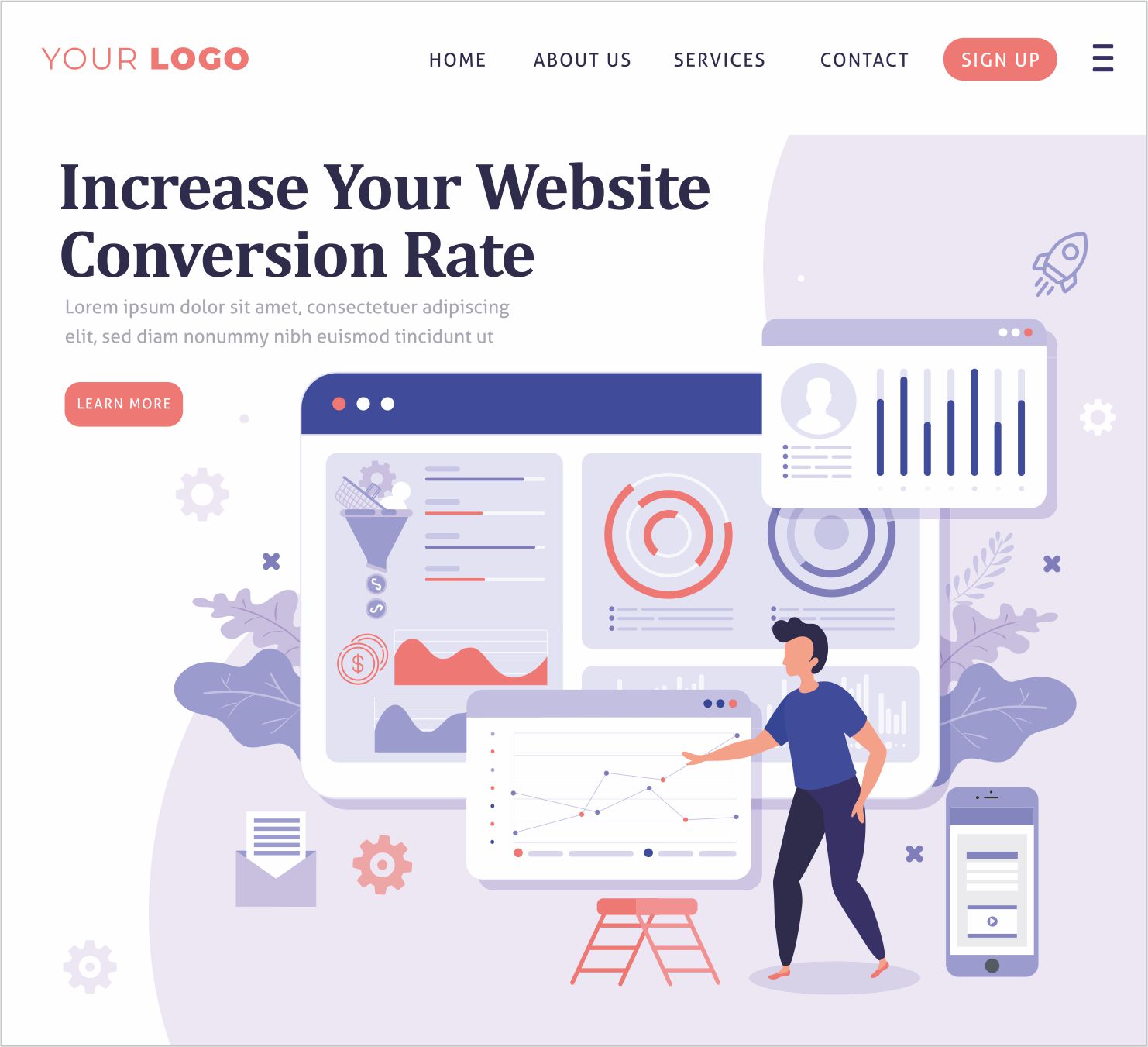Synopsis:
Every click on your website has potential, but only a fraction of visitors take the action you want them to. The difference between an underperforming site and one that drives real business growth often comes down to a few overlooked elements.
Businesses spend heavily on ads, SEO, and design, but conversions remain low. Why does this happen? What are others doing differently that makes visitors stay, engage, and buy? If you have ever wondered why your website isn’t delivering the results it should, you are about to discover strategies that can make all the difference.
Explore simple, proven ways to increase conversions by improving how people interact with your website.

Introduction
A beautifully designed website with strong traffic means little if visitors don’t convert. Whether you want users to buy, sign up, or request a demo, the real challenge lies in moving them from casual browsers to active customers.
Many businesses struggle here. Their content, design, or user flow leaves gaps that push potential customers away. This blog will effectively convert the fundamentals of conversion rate optimization and highlight practical strategies to increase conversion rate.
From fine-tuning CTAs to using social proof effectively, we will explore tested ways to improve website conversion rate that can drive measurable results. If you are looking for how to improve website conversion, this guide will help you close the gap between traffic and actual revenue.
Know the key features to have on your clothing eCommerce website.
What is Website Conversion?
The process of persuading website visitors to perform a certain action, such as making a purchase, filling in a contact form, subscribing to a newsletter, or downloading a whitepaper, is known as website conversion.
Converting website visitors into clients or leads for your organization is the goal of website conversion. A metric used to assess the accomplishment of the conversion goals of your website is conversion rate.
It shows what proportion of website visitors perform the intended activity on your website. Your conversion rate for that specific objective would be 5%, for instance, if 1000 people visited your website and 50 of them filled out a contact form.
Learn about 14 top-notch food and beverage brands.
For instance, an eCommerce site considers a sale as a conversion. A B2B company might see a filled-out lead form as a successful conversion. A blog may treat email subscriptions as conversions. Even a non-profit may track donations or volunteer sign-ups as conversions.
The website conversion rate is calculated by dividing the number of conversions by the total visitors and multiplying it by 100.
Struggling with Low Conversions?
Top 10 Ways to Increase Your Website Conversion Rate
1. Provide Appropriate Value Proposition
Visitors decide within seconds whether to stay or leave. A strong value proposition makes that decision easier. It tells them why your business matters and what sets it apart.
For example, if you run a SaaS platform, your value proposition might highlight time savings, cost efficiency, or unique features not offered by competitors. To make it effective, place your value proposition where users see it first; on the homepage banner, landing page headers, or product pages.
Pair it with visuals that reinforce the message. A clear and compelling value proposition immediately increases trust and contributes to a higher website conversion rate.
Discover top headless Magento websites.
2. Add Live Chat
Customers expect quick answers. A live hat tool bridges the gap between curiosity and conversion. Instead of waiting for an email reply, users can instantly connect with your brand. For example, if someone is unsure about product compatibility, live chat can resolve doubts on the spot, preventing drop-offs.
You can also integrate AI-powered chatbots for 24/7 coverage. These bots handle FAQs while forwarding complex queries to human agents. Live chat not only builds confidence but also shortens the buying cycle. For B2B businesses, it helps capture high-quality leads while they are actively engaged.
3. Boost Your Call to Actions (CTAs)
CTAs act as conversion triggers. The words, colors, and placement of your CTA can dramatically affect outcomes. Instead of vague buttons like “Click Here,” use direct, benefit-oriented language such as “Claim Your Free Trial” or “Get Instant Access.”
Study the 10 best cosmetic eCommerce brands.
Also, consider personalizing CTAs based on visitor behavior. For example, a returning visitor might see “Welcome Back: Continues Where You Left Off.” Small tweaks like this make CTAs feel more relevant and boost conversions. Remember, testing placement and visibility of CTAs across devices is critical since mobile visitors often scroll quickly.
4. A/B Testing
Guesswork is costly in digital marketing. A/B testing allows you to test different versions of pages, designs, or elements to see which works best. You can test something as small as a headline or as big as an entire landing page layout.
For example, a company may test two CTA buttons: one in green and one in red. If the green button generates more clicks, that insight can be applied site-wide. Regular testing helps eliminate poor-performing elements and gradually improves your conversion rate optimization strategy.
Find our top 5 checkout tools to increase your eCommerce website conversion.
5. Show Social Proof
People trust peer experiences more than brand claims. Social proof leverages psychology to influence decisions. This can include customer counts (Trusted by 50,000+ businesses), case studies, influencer endorsements, or even social media mentions.
Displaying real-time activity, such as “10 people purchased this product today,” creates urgency and credibility. For service-based businesses, showcasing industry awards or client logos builds instant trust. Social proof reduces hesitation, making users more likely to take the desired action.
6. Add Testimonials and Reviews
Testimonials and reviews are highly persuasive because they highlight real customer experiences. Reviews act as reassurance for new buyers who might otherwise hesitate. According to surveys, most consumers trust online reviews as much as personal recommendations.
Learn the cost of eCommerce website development services.
To maximize impact, display reviews on product pages, next to CTAs, or on checkout pages. For B2B companies, detailed case studies and video testimonials provide authenticity and authority. Incorporating both qualitative stories and star ratings adds balance and boosts confidence in your offerings.
7. Make Navigation Simpler
Cluttered websites confuse users. If visitors cannot find information quickly, they leave. Clear navigation helps visitors explore effortlessly and discover the right information. Group related pages, highlight your most important sections, and avoid overwhelming users with too many menu options.
For example, an eCommerce store might organize categories by product type, while a SaaS company could structure navigation by features, pricing, and case studies. Simple navigation improves the overall website optimization experience and naturally increases conversions by guiding users toward key actions.
8. Improved Loading Speed
Website speed is not just a technical detail; it directly affects business outcomes. A slow site frustrates visitors and increases bounce rates. Research shows that websites that load within 2-3 seconds have higher conversions compared to slower ones.
Improving speed requires optimizing images, reducing unnecessary scripts, leveraging browser caching, and investing in quality hosting. Tools like GTmetrix and Google PageSpeed Insights provide actionable recommendations. Fast-loading websites encourage visitors to explore further, boosting engagement and improving the website conversion rate.
9. Analyze User Behavior
Numbers tell you what is happening, but behavior tells you why. Heatmaps, scroll maps, and session recordings reveal how users interact with your site. For example, heatmaps may show that users ignore a CTA placed at the bottom of the page, while scroll maps highlight where attention drops off.
Learn everything you must about headless commerce development.
Analytics also show traffic sources, helping you understand whether organic, paid, or referral visitors convert best. With this knowledge, you can refine strategies and invest resources more effectively. Behavior analysis transforms assumptions into data-driven improvements that increase conversion rate steadily.
10. Simplify the Website Forms
Lengthy or complicated forms are one of the biggest barriers to conversions. Visitors lose interest if they are forced to provide too much information. Keep forms short and only request essential details.
For instance, instead of asking for full addresses in a newsletter sign-up, ask only for name and email. Multi-step forms can also be effective. Breaking down a long form into smaller sections feels less overwhelming.
Study the detailed analysis of the top 3 jewelry eCommerce websites.
Adding autofill and mobile-friendly fields improves usability further. Simplified forms remove friction and improve the chances of achieving a successful conversion rate optimization.















